What was the impact of the Dust Bowl?
During the 1930s, the Midwest experienced so much blowing dust in the air that the region became known as the Dust Bowl. The term also refers to the event itself, usually dated from 1934 through 1940. The heart of the Dust Bowl was the Texas panhandle and western Oklahoma, but atmospheric winds carried the dust so far that East Coast cities sometimes found a powdery layer of dirt on windows, streets, sidewalks and automobiles. On the Great Plains, however, dust storms were so severe that crops failed to grow, livestock died of starvation and thirst and thousands of farm families lost their farms and faced severe poverty.
Factors of the Dust Bowl
Most authorities cite two factors as the cause of the Dust Bowl. In the 1920s, with the coming of tractors and mechanical farm implements, farmers on the Great Plains plowed up huge tracts of land once covered with grasses that held the soil in place and helped to keep in moisture in the topsoil. Without the grass cover, the wind could lift dirt particles into the atmosphere where they were carried east by the prevailing winds. During the summers of 1934, 1936 and 1939-40, little rain fell, creating drought conditions in Iowa and across the Midwest. Extreme high temperatures topped 100 degrees sometimes for weeks at a time. Crops withered in the field and again, the soil was left with no cover to prevent the topsoil from blowing into the air.
The result was that the huge clouds of dust formed, often so strong that they blocked the sun creating darkness and limited visibility even during the day. Even when families stuffed rags under the doors and around the windows, dust filtered into homes covering everything. One woman recalled that when she sat up in the morning, she could see the silhouette of her head outlined in dust on her pillow.
The Dust Bowl and The Great Depression
The extreme weather came on top of farmers struggling to survive during the Great Depression. Guaranteed high prices during WWI and government appeals to farmers’ patriotism encouraged many to expand their herds and their cropland. When the war ended and demand for extra production fell, farmers continued to produce at record levels. Surpluses developed, and farm prices fell sharply making many farmers unable to pay their mortgages. Farm foreclosures across the Midwest skyrocketed and the situation looked desperate. Franklin Roosevelt’s New Deal boosted farm prices by paying farmers to limit production. While those programs were just beginning, however, the drought years of 1934 and 1936 made life even more difficult for farm families and the small towns that depended upon them. In Oklahoma and nearby regions, many families joined a mass migration to California, piling up whatever they could onto their automobiles. They became known as the "Okies."
Conservation Efforts
The Dust Bowl taught the United States to explore better approaches to land management. Western lands with too little rainfall to support grain crops like corn or wheat should be left as pasture to maintain a grass cover that can retain moisture and keep topsoil in place. The federal government began support for programs to plant trees as windbreaks, to terrace hillsides, and to implement other land management programs. It also produced a famous film, "The Plow That Broke the Plains," that dramatically illustrated the relationship between farming practices and the Dust Bowl.
Both weather and human efforts contributed to the Dust Bowl. Iowans who lived it remember the frightening appearance of dark clouds of descending dirt. They suffered through it but also learned some valuable lessons about the need to respect the natural environment.
Supporting Questions
What was the Dust Bowl?
- Dust Storm in Baca County, Colorado, 1935 (Image)
- Dust Storm in Eastern Colorado, c.a. 1936 (Image)
- Heavy Black Clouds of Dust Over Texas Panhandle, March 1936 (Image)
- Destroyed Orchard in Cimarron County, Oklahoma, April 1936 (Image)
- Dust Bowl Farmer in Cimarron County, Oklahoma, April 1936 (Image)
- Interview with Flora Robertson about Dust Storms in Oklahoma, August 5, 1940 (Audio)
How did people respond to the Dust Bowl?
- Proposed Migrant Camps in California for Relocated Dust Bowl Families, 1935 (Map)
- Dust Storm in Amarillo, Texas, April 1936 (Image)
- Oklahoma Farm Family on Highway between Blythe and Indio, California, August 1936 (Image)
- Dust Bowl Family from Paris, Arkansas, Leaves on Highway No.1, June 1938 (Image)
- "Why We Come to California," 1940 (Document)
- "Dust Control Treatment of Center's Land Area Slated," June 3, 1943 (Document)
How did the Dust Bowl affect Americans?
- "Dust Storm Headline Montage," between 1935 and 1942 (Document)
- "Migrant Mother" Florence Thompson with Her Children in Nipomo, California, February/March 1936 (Image)
- Farmer's Son Playing on a Large Soil Drift in Liberal, Kansas, March 1936 (Image)
- Manzanar Free Press Special Anniversary Edition, March 20, 1943 (Document)
- "Big Dust Storm Hits Project Sun. Afternoon" Newspaper Article, July 19, 1943 (Document)
- Iowa Public Television's "The Dust Bowl," 1979 (Video)
- Iowa Public Television's "The Depression, the Family Farm and the New Deal," April 28, 2015 (Video)
| Dust Bowl Source Set Teaching Guide |
| Printable Image and Document Guide |
Dust Storm in Baca County, Colorado, 1935
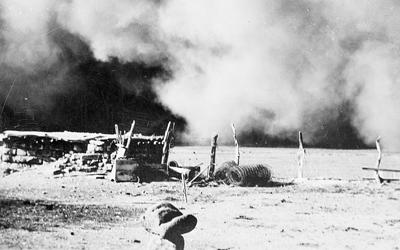
Description
The photograph by J.H. Ward shows a dust storm moving in on a farm in Baca County, Colorado. Baca County is located in the southeasternmost part of the state.
Dust Storm in Eastern Colorado, ca. 1936
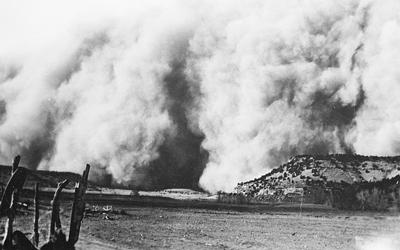
Description
This J.H. Ward photograph shows a huge dust storm moving toward a hill and through eastern Colorado.
Heavy Black Clouds of Dust Over Texas Panhandle, March 1936

Description
This photograph by Arthur Rothstein in 1936 shows a very heavy black cloud of dust behind a single car that is driving on a country road. The image was taken in the "Texas panhandle," with is the straight and narrow top part of the state bordering Oklahoma and New…
Destroyed Orchard in Cimarron County, Oklahoma, April 1936

Description
The 1936 photograph by famed-American photographer Arthur Rothstein captures dry soil piling up high toward the top of dead trees in an orchard. The image was taken in Cimarron County, Oklahoma, which is the westernmost part of the state.
Dust Bowl Farmer in Cimarron County, Oklahoma, April 1936
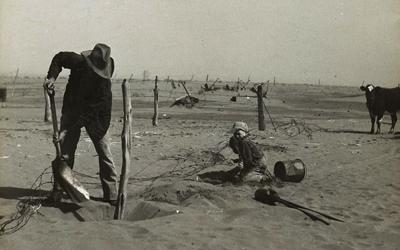
Description
The 1936 photograph by Arthur Rothstein shows a farmer digging up a fence and attempting to move it higher to prevent it from being buried in the dust that is accumulating around it. There is a young boy on his knees close by. This photo was taken in Cimarron…
Interview with Flora Robertson about Dust Storms in Oklahoma, August 5, 1940
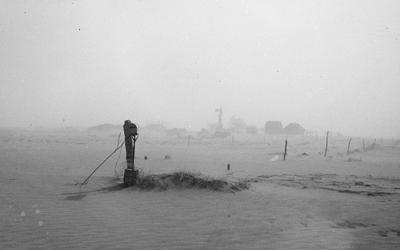
Description
Flora Robertson is heard being interviewed about dust storms in Oklahoma. Robertson lived in the state with her family during the Dust Bowl. In this audio file, she discusses the fear of being in a dust storm. Flora and her family ultimately moved to…
Proposed Migrant Camps in California for Relocated Dust Bowl Families, 1935
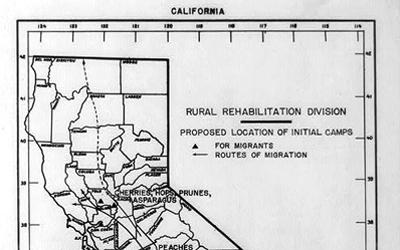
Description
The map was designed to assist Dust Bowl families in relocating to migrant camps in California. It was created by the Rural Rehabilitation Division to show areas where different crops are grown, proposed location of initial camps for migrants and routes of…
Dust Storm in Amarillo, Texas, April 1936
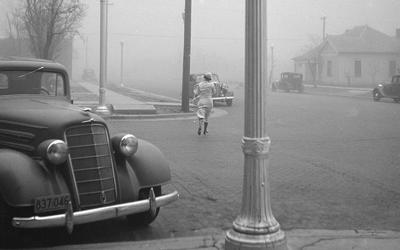
Description
This Arthur Rothstein photograph shows a parked car in the foreground of a town with a woman wearing a dress holding her hat on her head. A dust storm can be seen engulfing the town of Amarillo, Texas.
Oklahoma Farm Family on Highway between Blythe and Indio, California, August 1936
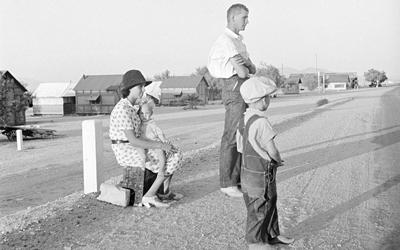
Description
This photograph is an example of self-resettlement in California. This Oklahoma farm family is waiting along a highway between Blythe and Indio. Forced by the drought of 1936 to abandon their farm, they set out with their children to drive to California. They picked cotton…
Dust Bowl Family from Paris, Arkansas, Leaves on Highway No.1, June 1938
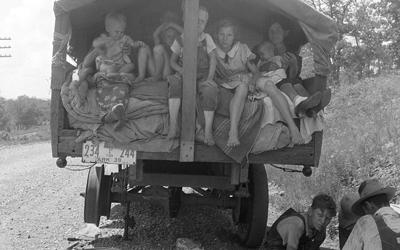
Description
This photograph, taken by famed-American photographer Dorothea Lange, shows a family that was from Paris, Arkansas, relocating during the Dust Bowl era. The title indicates they anticipate ending up in California one day — as many families did.
"Why We Come to California," 1940
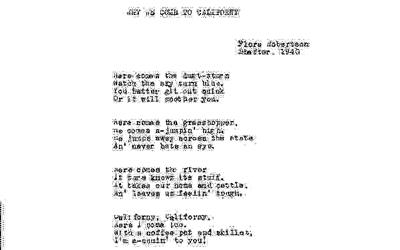
Description
This document is a poem written in 1940 by a woman, Flora Robertson, who lived during the Dust Bowl in Oklahoma. Flora left her home and settled in a migrant camp in California.
"Dust Control Treatment of Center's Land Area Slated," June 3, 1943
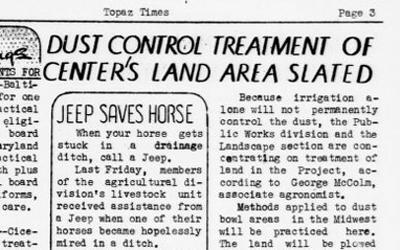
Description
The Topaz Times is a Japanese evacuation and relocation newspaper out of Utah. The article outlines how the public works division are treating the land in Utah to control the dust, since irrigation alone does not work.
"Dust Storm Headline Montage," between 1935 and 1942
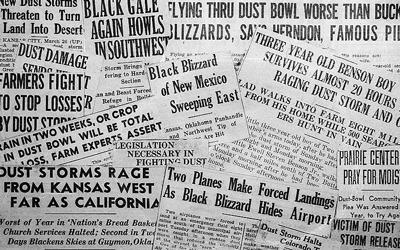
Description
The montage shows a collection of headlines from various newspapers that focus on the dust storms and the Dust Bowl.
"Migrant Mother" Florence Thompson with Her Children in Nipomo, California, February/March 1936

Description
This photograph by Dorothea Lange is part of a well-known collection taken of Florence Thompson with several of her children during the Dust Bowl. The photo collection, known as the "Migrant Mother" series, shows Thompson with her children in a tent shelter in…
Farmer's Son Playing on a Large Soil Drift in Liberal, Kansas, March 1936
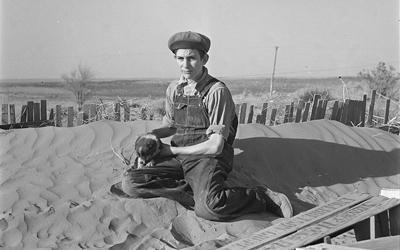
Description
This photograph by Arthur Rothstein shows a young boy holding what appears to be a football sitting on top of a very large dune of dust. The photo was taken in Liberal, Kansas, which is located in the southwest part of the state.
Manzanar Free Press Special Anniversary Edition, March 20, 1943
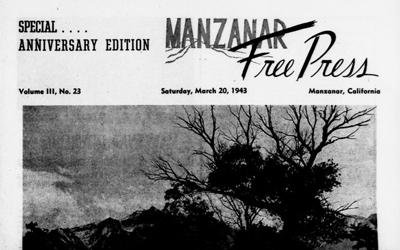
Description
The Manzanar Relocation Center Administration and newspaper of Manzanar Community Enterprises is a publication of a Japanese Internment Camp. The front page of this edition highlights a piece of writing about how a year has gone by since the author has been at the…
"Big Dust Storm Hits Project Sun. Afternoon" Newspaper Article, July 19, 1943
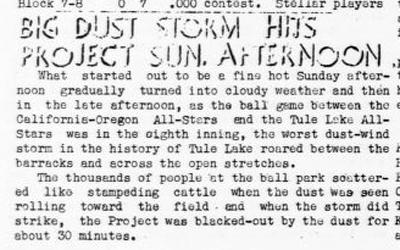
Description
This newspaper article from the The Daily Tulean Dispatch internment camp in California is written about a baseball game that was interrupted by a massive dust storm. It describes what the people in attendance did in response to seeing the dust cloud approaching.…
Iowa Public Television's "The Dust Bowl," 1979

Description
This video, produced by Iowa Public Television, documents the impact of the Dust Bowl on Iowa farms.
Iowa Public Television's "The Depression, the Family Farm and the New Deal," April 28, 2015

Description
This segment from Iowa Public Television's documentary, "The People in the Pictures: Stories from the Wettach Farm Photos," features original photography and first-person accounts of farm life in rural America during the Great Depression and early 20th century. …
Additional Resources
- Voices from the Dust Bowl
This Library of Congress online gallery, known as the "Charles L. Todd and Robert Sonkin Migrant Worker Collection," contains selections that documented the everyday life of residents of Farm Security Administration (FSA) migrant work camps in central California in 1940 and 1941. - The Dust Bowl Primary Source Set
This primary source set about the Dust Bowl from the Library of Congress includes a number of photos of Americans during the Dust Bowl. - Stanford History Education Group – The Dust Bowl
This website contains education materials about the Dust Bowl for teachers to use in the classroom. - Wessels Living History Farm – The Dust Bowl
This webpage from Wessels Living History Farm in Nebraska focuses on the effects of the Dust Bowl in the Midwest in the 1930s. - Library of Congress Dust Bowl Teaching Guide
This Library of Congress teaching guide works in tandem with the LOC's primary source set on the Dust Bowl.
Iowa Core Social Studies Standards (9-12th Grade)
Listed below are the Iowa Core Social Studies content anchor standards that are best reflected in this source set. The content standards applied to this set are high school-age level and encompass the key disciplines that make up social studies for 9th through 12th grade students.
| No. | Standard Description |
| SS-Geo.9-12.13. | Employ maps to display and explain the spatial patterns of human and environmental characteristics. |
| SS-Geo.9-12.18. | Evaluate the impact of human settlement activities on the environmental and cultural characteristics of specific places and regions. |
| SS-Geo.9-12.19. | Analyze the reciprocal relationship between historical events and the spatial diffusion of ideas, technologies, cultural practices and the distribution of human population. |
| SS-Geo.9-12.21. | Analyze how changes in the environmental and cultural characteristics of a place or region influence spatial patterns of trade and land use. |
| SS-Geo.9-12.23. | Analyze the consequences of human-made and natural catastrophes on global trade, politics, and human migration. |
| SS-Geo.9-12.24. | Identify and evaluate Iowans or groups of Iowans who have influenced Iowa’s environmental or cultural geography. |